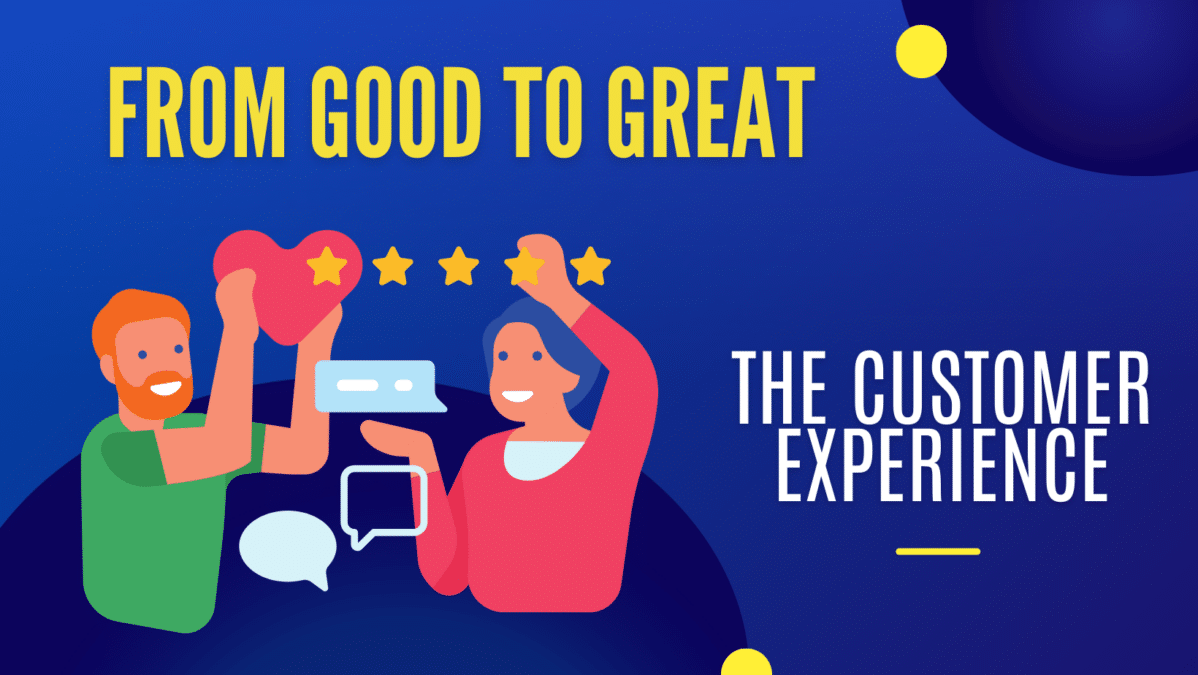
What You Need To Know About Creating An AI-Powered Site
June 8, 2023
The Most Hypnotic Trends In Web Design This Year
June 22, 2023From Good to Great: How to Turn a Satisfied Customer into a Delighted Customer
Delight your customers and foster loyalty with these key strategies for creating a memorable customer experience. Plus, get access to our free ebook.
Every business wants to have satisfied customers. But what if you could take it further and turn those satisfied customers into delighted ones? The difference between a satisfied customer and a delighted customer is huge. A satisfied customer may return to your business, but a delighted customer will become a loyal customer and advocate for your brand.
In this blog, we’ll explore how you can take your customer experience from good to great by focusing on the customer journey and using the customer flywheel.
Understanding the Customer Journey
The customer journey refers to the entire process a customer goes through when interacting with your business, from the first point of contact to the final purchase. To turn a satisfied client into a delighted client, you need to understand the stages of the customer journey and identify areas where you can improve their experience.
Start by mapping out your customer journey, from initial awareness to post-purchase support. This will help you identify the key touchpoints where you can make a difference in the customer experience. Some touchpoints may include:
- Awareness: How did the patron first hear about your business? Was it through a Google search, social media, or word of mouth?
- Consideration: What research did they do before making a purchase? Did they read reviews or compare prices?
- Purchase: How easy was it for them to make a purchase? Was the checkout process smooth and intuitive?
- Post-Purchase: What kind of support do you offer after a purchase? Is it easy for the customer to get help with questions or concerns?
Using the Customer Flywheel
The customer flywheel is a concept popularized by HubSpot that focuses on creating a positive customer experience that leads to customer retention and advocacy. The flywheel has three main stages: Attract, Engage, and Delight.
- Attract: The flywheel’s first stage is about attracting new customers. This can be done through marketing and advertising efforts highlighting your unique value proposition.
- Engage: Once you’ve attracted new clients, engaging with them and providing a positive experience is essential. This can be done through personalized communication, easy-to-use websites and apps, and responsive customer service.
- Delight: The final stage of the flywheel is where you turn satisfied customers into delighted customers. This can be done by going above and beyond to surprise and delight them, such as sending a personalized thank you note or offering a discount on their next purchase.
Flywheel vs. Sales Funnel
The flywheel and the sales funnel are frameworks businesses can use to understand and improve customer acquisition and retention strategies. However, there are some key differences between the two.
The sales funnel is a linear model that represents the customer journey as a series of stages, starting with awareness and ending with purchase. The stages of the funnel typically include:
- Awareness
- Interest
- Consideration
- Intent
- Evaluation
- Purchase
The goal of the sales funnel is to move end users through these stages and ultimately convert them into paying customers. Once the customer makes a purchase, they are often considered “closed,” and the process ends.
The flywheel model, on the other hand, is a circular model that represents the ongoing relationship between a business and its clientele. The flywheel has three stages: attract, engage, and delight. This model aims to create a positive customer interaction that leads to customer retention and advocacy. In this way, the flywheel emphasizes the importance of the customer experience beyond the point of purchase.
Another key difference is that the sales funnel focuses primarily on customer acquisition, while the flywheel emphasizes acquisition and retention. The flywheel recognizes that customer retention is just as important as customer acquisition, if not more so. By creating a positive customer experience and delighting patrons, businesses can encourage repeat purchases and turn satisfied customers into loyal advocates for their brand.
While both the sales funnel and the flywheel are valuable frameworks for understanding and improving acquisition and retention, the flywheel differs in its emphasis on creating a positive customer experience that leads to ongoing customer retention and advocacy and in its circular rather than a linear model of the customer journey.
WHAT THE BUYER’S JOURNEY LOOKS LIKE
Tips for Turning a Satisfied Customer into a Delighted Customer
Now that you understand the customer journey and the customer flywheel, here are some tips for turning a satisfied customer into a delighted customer:
Personalize the experience:
Personalization is a key component of creating a great customer experience. Patrons want to feel like they are more than just a number to your business. They want to feel valued and appreciated. One way to do this is to personalize your communication with them. This can include using their name in emails or addressing them by name in phone calls.
Another way to personalize the experience is to offer product recommendations based on their previous purchases. This shows that you understand their needs and are invested in their success. Consider implementing a recommendation engine on your website or using customer data to send personalized product recommendations via email.
Focus on the details:
The small things can make a big difference in their experience. For example, make sure your website is easy to navigate and user-friendly. Users should be able to find what they’re looking for quickly and easily. Make sure your packaging is attractive and reflects your brand’s personality. A well-packaged product can make a lasting impression on the audience and encourage them to share their positive experiences with others.
Clear and concise communication is also essential. People want to know what they can expect from your business, so make sure your communication is clear and transparent. This can include order confirmations, shipping notifications, and customer service emails.
Offer exceptional customer service:
To create a great experience, businesses must focus on their touchpoints and address pain points effectively. Customer feedback is also crucial to providing exceptional customer service. Responding promptly to customer inquiries and concerns is vital. It’s important to train the customer service team to handle any issue that may arise and empower them to go above and beyond to resolve consumer concerns. Doing so can turn a negative experience into a positive one, which enhances their overall experience.
Surprise and delight:
To create a positive interaction with your brand and enhance customer satisfaction and customer loyalty, it’s crucial to delight your customers. One way to achieve this is by offering surprises and delights that make their experience memorable. Such experiences may include incredible discounts, gifts, or even a handwritten note to show appreciation for their business. Additionally, businesses can consider implementing a loyalty program that rewards patrons for their continued business, which can encourage repeat business and turn satisfied customers into loyal advocates for your brand.
From Satisfied to Delighted Advocates
To improve the customer experience and turn a satisfied customer into a delighted customer, businesses should create a customer journey that ensures customers feel valued throughout their interaction with the product or service. This requires a focus on personalization, attention to detail, exceptional customer service, and surprises. By implementing these strategies and focusing on the customer flywheel, businesses can create a memorable experience that will turn satisfied customers into delighted customers and loyal advocates for their brand.




